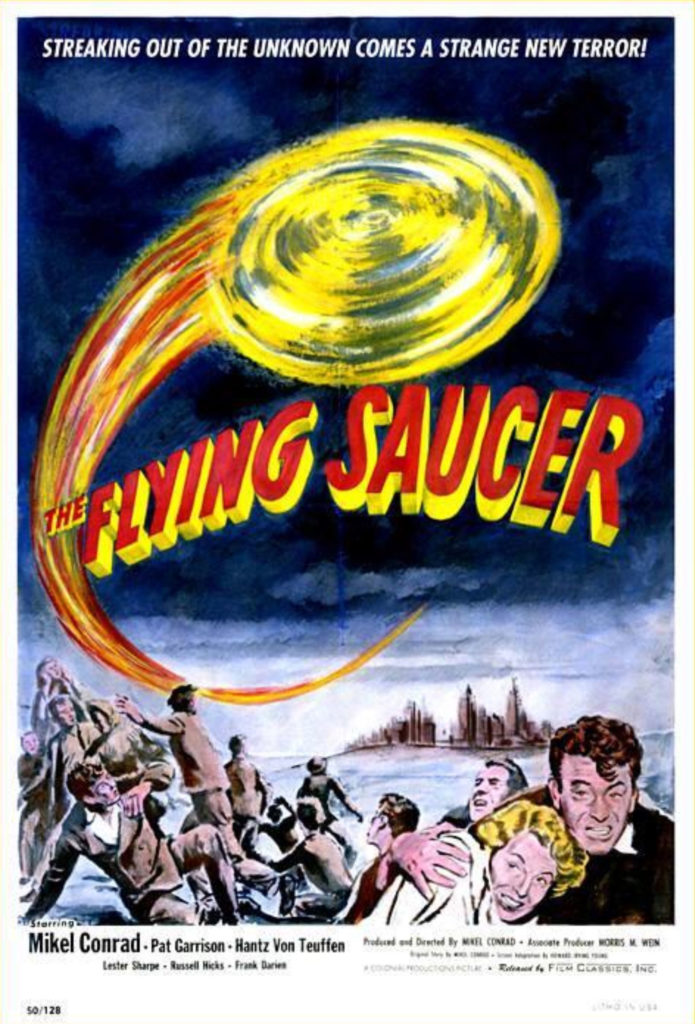To spoil, or not? That is the question facing all critical reviewers of film, even those poor, unpaid wretches who operate on the fringes. Is the big twist in a film something sacred, to be preserved without forewarning potential viewers, or something so linked to even the lightest analysis of a film that it must be revealed? I imagine some people lose sleep over this. I, for one, like being surprised by a story. On the other hand, I do not like being disappointed by a poor reveal. In the end, it’s up to the discretion of the reviewer. If you, dear soul, have ended up in this corner of the internet reading about this film, then I doubt it is your first stop, so I feel I am risking little by writing that there is neither hide nor hair of an alien in The Flying Saucer, the UFO flick from 1950.
UFOs, specifically ‘flying saucers,’ had been in the public consciousness at the time owing to the detailed account of Kenneth Arnold, a pilot who claimed to have sighted a formation of strange aircraft bounding through the air over Mineral, Washington, in 1947. The press ran with it, coining the term, and a couple of years later, smalltime actor Mikel Conrad managed to enter the big time of b-pictures, conceiving, producing, directing, and starring in The Flying Saucer, retroactively billed as the first UFO flick.
Conrad plays Mike Trent, a millionaire socialite who loves the New York nightlife. After a series of UFO sightings around the country has spooked the federal government, Trent is enlisted to go undercover in Alaska and investigate. How that makes sense requires some twists and turns. First, Trent is a vet of World War Two, making him willing to serve his country once again. Second, he’s from Juneau,  Alaska, making his sudden reappearance under the guise of recuperating from a nervous breakdown plausible, I guess. Third, the latest sightings of a UFO have been in the Juneau area. Fourth, a government agent in the area went missing after reporting the presence of Soviet agents. Yeah, it’s still a stretch.
Alaska, making his sudden reappearance under the guise of recuperating from a nervous breakdown plausible, I guess. Third, the latest sightings of a UFO have been in the Juneau area. Fourth, a government agent in the area went missing after reporting the presence of Soviet agents. Yeah, it’s still a stretch.
The important thing for viewers is that a shitload of this film’s 69-minute running time was shot outside during a gorgeous Alaskan summer. This film may not have been cared for over the years, and the 1.37:1 aspect ratio doesn’t lend itself to panoramas, but the views of mountains and glaciers are spectacular. Conrad likely chose the location after being in the area for the filming of Arctic Manhunt, and found a way to make his return trip a business expense.
After spending some time at a cabin gathering more nature footage with fellow agent Vee Langley (Pat Garrison), who is pretending to be Trent’s nurse, Trent drinks his way through Juneau and literally stumbles into the main plot. There is a flying saucer, but there are no aliens to go with it. I won’t spoil things further, but the final act consists of a race between Trent and Soviet spies to take possession of the saucer, which represents a massive leap forward in aerospace technology, and with it, massive implications for the Cold War.
So, this sci-fi flick has turned into a political thriller. That’s no sin. What gets this flick entrance into the Shitty Movie Sundays Watchability Index is general quality. It’s a b-movie through and through, the only extravagant expense the location work in Alaska. The dialogue is silly, the acting a match, the sets cheap, and the effects even more so. It’s workaday schlock. One can zip through this film like passing scenery on the highway. It’s there, and then it’s gone. At least the view was nice.
Of final note is a scene where Trent discovers the saucer hidden away underneath a remote shack. John Carpenter must have had this scene in mind for a sequence near the end of his remake of The Thing. That’s not a knock. Rather, it’s more evidence, as if any was needed, that Carpenter was a student of film as much as a filmmaker. A surprising number of filmmakers are not.
The Flying Saucer was the first UFO flick, and it left a lot of room for improvement for all that came after. It settles into the lower half of the index, displacing The Devil Below at #248. It’s interesting as a museum piece of film, but not much more.
